Entry Database : PDB / ID : 5e1sTitle The Crystal structure of INSR Tyrosine Kinase in complex with the Inhibitor BI 885578 Insulin receptor Keywords / / / / Function / homology Function Domain/homology Component
/ / / / / / / / / / / / / / / / / / / / / / / / / / / / / / / / / / / / / / / / / / / / / / / / / / / / / / / / / / / / / / / / / / / / / / / / / / / / / / / / / / / / / / / / / / / / / / / / / / / / / / / / / / / / / / / / / / / / / / / / / / / / / / / / / / / / / / / Biological species Homo sapiens (human)Method / / / Resolution : 2.264 Å Authors Kessler, D. / Zahn, S. / Sanderson, M. / Wolkerstorfer, B. Journal : Mol.Cancer Ther. / Year : 2015Title : BI 885578, a Novel IGF1R/INSR Tyrosine Kinase Inhibitor with Pharmacokinetic Properties That Dissociate Antitumor Efficacy and Perturbation of Glucose Homeostasis.Authors : Sanderson, M.P. / Apgar, J. / Garin-Chesa, P. / Hofmann, M.H. / Kessler, D. / Quant, J. / Savchenko, A. / Schaaf, O. / Treu, M. / Tye, H. / Zahn, S.K. / Zoephel, A. / Haaksma, E. / Adolf, G.R. / Kraut, N. History Deposition Sep 30, 2015 Deposition site / Processing site Revision 1.0 Oct 14, 2015 Provider / Type Revision 1.1 Dec 16, 2015 Group Revision 1.2 Jan 10, 2024 Group / Database references / Refinement descriptionCategory chem_comp_atom / chem_comp_bond ... chem_comp_atom / chem_comp_bond / database_2 / pdbx_initial_refinement_model Item / _database_2.pdbx_database_accession
Show all Show less
 Yorodumi
Yorodumi Open data
Open data Basic information
Basic information Components
Components
 Keywords
Keywords TRANSFERASE /
TRANSFERASE /  Kinase / INSR /
Kinase / INSR /  IGF-1R / Inhibitor
IGF-1R / Inhibitor Function and homology information
Function and homology information insulin-like growth factor II binding / male sex determination / exocrine pancreas development /
insulin-like growth factor II binding / male sex determination / exocrine pancreas development /  insulin receptor complex /
insulin receptor complex /  insulin-like growth factor I binding /
insulin-like growth factor I binding /  insulin receptor activity / positive regulation of protein-containing complex disassembly ...regulation of female gonad development / positive regulation of meiotic cell cycle / positive regulation of developmental growth /
insulin receptor activity / positive regulation of protein-containing complex disassembly ...regulation of female gonad development / positive regulation of meiotic cell cycle / positive regulation of developmental growth /  insulin-like growth factor II binding / male sex determination / exocrine pancreas development /
insulin-like growth factor II binding / male sex determination / exocrine pancreas development /  insulin receptor complex /
insulin receptor complex /  insulin-like growth factor I binding /
insulin-like growth factor I binding /  insulin receptor activity / positive regulation of protein-containing complex disassembly / cargo receptor activity /
insulin receptor activity / positive regulation of protein-containing complex disassembly / cargo receptor activity /  dendritic spine maintenance /
dendritic spine maintenance /  insulin binding /
insulin binding /  PTB domain binding / adrenal gland development / neuronal cell body membrane / Signaling by Insulin receptor / IRS activation / activation of protein kinase activity / amyloid-beta clearance / positive regulation of respiratory burst /
PTB domain binding / adrenal gland development / neuronal cell body membrane / Signaling by Insulin receptor / IRS activation / activation of protein kinase activity / amyloid-beta clearance / positive regulation of respiratory burst /  regulation of embryonic development / positive regulation of receptor internalization / transport across blood-brain barrier /
regulation of embryonic development / positive regulation of receptor internalization / transport across blood-brain barrier /  insulin receptor substrate binding / positive regulation of glycogen biosynthetic process / epidermis development / Signal attenuation /
insulin receptor substrate binding / positive regulation of glycogen biosynthetic process / epidermis development / Signal attenuation /  phosphatidylinositol 3-kinase binding / heart morphogenesis / dendrite membrane / Insulin receptor recycling /
phosphatidylinositol 3-kinase binding / heart morphogenesis / dendrite membrane / Insulin receptor recycling /  insulin-like growth factor receptor binding / neuron projection maintenance / positive regulation of glycolytic process / activation of protein kinase B activity / positive regulation of mitotic nuclear division / Insulin receptor signalling cascade /
insulin-like growth factor receptor binding / neuron projection maintenance / positive regulation of glycolytic process / activation of protein kinase B activity / positive regulation of mitotic nuclear division / Insulin receptor signalling cascade /  receptor-mediated endocytosis /
receptor-mediated endocytosis /  learning /
learning /  caveola / positive regulation of glucose import / positive regulation of MAP kinase activity /
caveola / positive regulation of glucose import / positive regulation of MAP kinase activity /  receptor internalization /
receptor internalization /  receptor protein-tyrosine kinase /
receptor protein-tyrosine kinase /  memory / cellular response to growth factor stimulus / peptidyl-tyrosine phosphorylation / cellular response to insulin stimulus / positive regulation of nitric oxide biosynthetic process / male gonad development / late endosome / insulin receptor signaling pathway /
memory / cellular response to growth factor stimulus / peptidyl-tyrosine phosphorylation / cellular response to insulin stimulus / positive regulation of nitric oxide biosynthetic process / male gonad development / late endosome / insulin receptor signaling pathway /  glucose homeostasis /
glucose homeostasis /  amyloid-beta binding / PI5P, PP2A and IER3 Regulate PI3K/AKT Signaling /
amyloid-beta binding / PI5P, PP2A and IER3 Regulate PI3K/AKT Signaling /  protein tyrosine kinase activity / positive regulation of MAPK cascade / protein autophosphorylation / positive regulation of phosphatidylinositol 3-kinase/protein kinase B signal transduction /
protein tyrosine kinase activity / positive regulation of MAPK cascade / protein autophosphorylation / positive regulation of phosphatidylinositol 3-kinase/protein kinase B signal transduction /  lysosome /
lysosome /  receptor complex / endosome membrane / positive regulation of cell migration / symbiont entry into host cell / positive regulation of protein phosphorylation / G protein-coupled receptor signaling pathway / protein domain specific binding /
receptor complex / endosome membrane / positive regulation of cell migration / symbiont entry into host cell / positive regulation of protein phosphorylation / G protein-coupled receptor signaling pathway / protein domain specific binding /  axon / external side of plasma membrane /
axon / external side of plasma membrane /  protein phosphorylation / positive regulation of cell population proliferation / protein-containing complex binding / regulation of DNA-templated transcription / GTP binding / positive regulation of DNA-templated transcription / extracellular exosome /
protein phosphorylation / positive regulation of cell population proliferation / protein-containing complex binding / regulation of DNA-templated transcription / GTP binding / positive regulation of DNA-templated transcription / extracellular exosome /  ATP binding /
ATP binding /  membrane / identical protein binding /
membrane / identical protein binding /  plasma membrane
plasma membrane
 Homo sapiens (human)
Homo sapiens (human) X-RAY DIFFRACTION /
X-RAY DIFFRACTION /  SYNCHROTRON /
SYNCHROTRON /  MOLECULAR REPLACEMENT / Resolution: 2.264 Å
MOLECULAR REPLACEMENT / Resolution: 2.264 Å  Authors
Authors Citation
Citation Journal: Mol.Cancer Ther. / Year: 2015
Journal: Mol.Cancer Ther. / Year: 2015 Structure visualization
Structure visualization Molmil
Molmil Jmol/JSmol
Jmol/JSmol Downloads & links
Downloads & links Download
Download 5e1s.cif.gz
5e1s.cif.gz PDBx/mmCIF format
PDBx/mmCIF format pdb5e1s.ent.gz
pdb5e1s.ent.gz PDB format
PDB format 5e1s.json.gz
5e1s.json.gz PDBx/mmJSON format
PDBx/mmJSON format Other downloads
Other downloads https://data.pdbj.org/pub/pdb/validation_reports/e1/5e1s
https://data.pdbj.org/pub/pdb/validation_reports/e1/5e1s ftp://data.pdbj.org/pub/pdb/validation_reports/e1/5e1s
ftp://data.pdbj.org/pub/pdb/validation_reports/e1/5e1s
 Links
Links Assembly
Assembly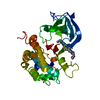
 Components
Components / IR
/ IR
 Homo sapiens (human) / Gene: INSR / Production host:
Homo sapiens (human) / Gene: INSR / Production host: 
 Spodoptera frugiperda (fall armyworm)
Spodoptera frugiperda (fall armyworm) receptor protein-tyrosine kinase
receptor protein-tyrosine kinase Water
Water X-RAY DIFFRACTION
X-RAY DIFFRACTION Sample preparation
Sample preparation
 SYNCHROTRON / Site:
SYNCHROTRON / Site:  SLS
SLS  / Beamline: X06SA / Wavelength: 1 Å
/ Beamline: X06SA / Wavelength: 1 Å : 1 Å / Relative weight: 1
: 1 Å / Relative weight: 1  Processing
Processing :
:  MOLECULAR REPLACEMENT
MOLECULAR REPLACEMENT Movie
Movie Controller
Controller



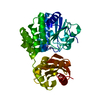

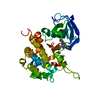

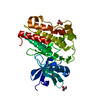

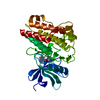

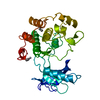
 PDBj
PDBj














